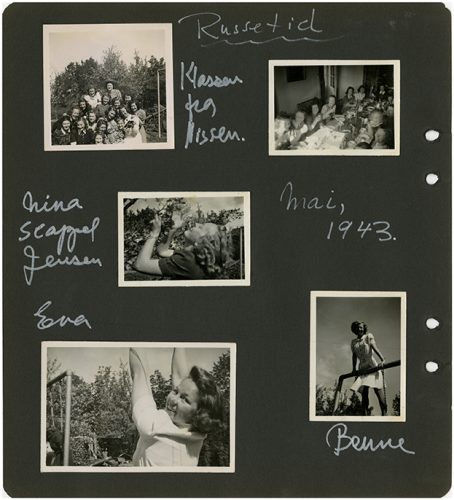Writing any blog post about a person whose materials are in Special Collections and Archives presents research joys and challenges, with the challenges normally being resolved using resources such as Ancestry.com, online biographies, obituaries, and collections materials. This is my first post where I could not glean much from the usual resources. It became obvious early on, I needed to research traveling down a unique path in order to get to know Eva Rodtwitt, the native Norwegian who came to teach at Wake Forest in 1966.
The Eva Rodtwitt Photo Collection, available in Digital Collections, contains selected photo albums from the Eva Rodtwitt Papers that span 1905 to 1964. The albums cover several years prior to Eva’s birth through to her young adult years, including the five years that Eva and her family lived under the WWII Nazi occupation of Norway. The albums proved to be a strikingly beautiful pictorial documentation of Eva’s life. Photographs are labeled primarily in Norwegian and with the much needed assistance of translation websites, I was able to understand Rodtwitt’s life.

Eva was born in Oslo, Norway on January 17, 1924, to Trygve and Frida Maria Rodtwitt. Eva’s father worked aboard a shipping vessel, and her mother cared for Eva and her siblings, Jan and Klaus. A photo of Eva’s class in 1933, when she was 11 years old, sets the scene of her early education in Oslo. She attended Nissen Girl’s School, as seen in a picture she labels “Nissen’s pikescole” and “Klassen fra Nissen” in this album.
On April 9, 1940, when Eva was “16 years old, young and naive” as she later wrote, German warships entered major Norwegian ports, from Narvik in the north to Oslo in the south, deploying several hundred thousand German troops into Norway. There was one German soldier for every 8 Norwegians for the five years of the occupation, making Norway the most heavily fortified country during WWII. (Sources: Norway | Holocaust Encyclopedia, In Nazi-Occupied Norway, Glimpsing the World Hitler Wanted | Time)
In 1980, Eva reflected on the years she lived under occupation in a newspaper article titled “Rodtwitt recalls occupation of Norway.” Rodtwitt shared with her interviewer that “the occupation by Hitler’s troops marked her the most”. She lost her adolescent freedoms. Her schools were closed for months at a time due to the arrest of teachers and professors. German language replaced English in schools, radios were confiscated, and newspapers were run by the Nazi occupiers. There was often a 7 pm curfew and food shortages left potatoes as the main sustenance, with minimal amounts of available sugar and bread. There was no butter or vegetable oil, and when oil was needed, cod liver oil was the substitute. Eva Rodtwitt described the war years as “long and painful”, but her photo albums show how she did find joy spending time with friends as they skied, sailed, and sunbathed along the rocky coast of Norway in the midst of war.
May 8, 1945, brought Norway the liberation it had longed for. Eva wrote in her photo album for summer 1945, “5 års tysk okupay” – “5 years German occupation.”* Years later, in “Remembering Day of Liberation and Joy,” Eva wrote of that liberation: “freedom exploded in Norway too and what a liberation day it was!” This turning point brought profound “joy and jubilation” to Eva and the people of Norway. They were free once more. In this after-war period, photos show Eva traveling to France where she studied at Paris’ Sorbonne in 1947 and 1951. She enrolled at the University of Oslo where she served as chairwoman of the Student French Club and the Association of Oslo Lektors of French. After receiving her degree in History in 1948, she spent the summer of 1949 in England as a governess, studying at Oxford. She then received a degree in French in 1953 at the University of Oslo, and she left Oslo to teach at Kristiansand Cathedral School in 1954. A former student of Eva’s described her as “a breath of fresh air to join the somewhat aged males who dominated the faculty.” She was “not only inspiring, with great knowledge in her subject, she was extremely talented.” Her youth and energetic spark made her a beloved teacher at Kristiansand, according to former student and friend Ingvard Eftevåg.
Rodtwitt later joined the faculty at Foss Skole, Foss Upper Secondary School, to teach, and her photos document her involvement with the drama club and school theater productions. It was during this time that Eva developed the desire to study English, American culture, and American teaching methods in an immersive environment, so she applied for and was granted the Smith Munt Grant and a Fulbright Grant for visiting international teachers. Eva, a passenger on the ship Bergensfjord, departed Norway August 24, 1959, and arrived in the US on August 31. She spent three months studying American Civilization at the University of Wyoming and 3 months traveling. Her final stop was at Wake Forest University, where French professor and department chair Dr. Harold Parcell asked Eva if she would some day come to Wake Forest to teach for a year.
She came to Wake Forest in 1966 as a guest lecturer teaching French and French Literature. She then returned to Norway for one year, but chose to return to Winston-Salem to teach full time at Wake Forest. Her dedication to teaching French earned Eva the Ordre des Palmes Académiques, bestowed by France, in 1978. She felt strongly that her students should learn a foreign language, develop a political awareness and commitment to world affairs. Rodtwitt was instrumental in Wake Forest’s commemoration of the French Revolution in 1989 since the US and France shared in the development of each other’s governments with their close ties during the Revolutionary War.
Eva retired from Wake Forest in June 1997, and as long as it was possible, she spent her summers at her beloved summer home, “Tuskulum,” along the south coast of Norway in the Kristiansand area. She kept a framed photo of 1945’s Liberation Day on her wall, and she felt a life long gratitude to “the American people and all the soldiers who risked their lives to liberate us from the nightmare of tyranny.” Eva Rodtwitt spent her later years in Winston Salem at Arbor Acres and she passed away there on March 3, 2020.
*Updated with Norweigan translation, May 2023.

7 Comments on ‘Eva Rodtwitt’s Life in Norway, and Occupied Norway’
Nancy, thanks so much for giving this account of Eva’s early life, her photographs and memories really provide such a unique perspective.
Nancy- This is a great account of a remarkable life. I saw some of these photos when I helped at Elizabeth Phillips’ memorial service. I was amazed at those women camped in little huts along the fjords of Norway. Thank you for this post!
Thank you for taking us through these scrapbooks, Nancy! Eva’s documentation of her interesting, varied life is a gift.
Nancy, This is a beautifully composed, informative article about a woman who was able to become a fascinating, productive member of the Wake Forest community. Thanks for your diligent research.
This an impressive and informative piece. Thank you.
The translation of “ tysh” as “hush” is incorrect. The word is “ tysk” spelled with “k” and is the Norwegian word for “ German”. Tyskland is the word for Germany. The translation of the phrase, then, would “ five years German occupation.
Thank you for the translation, Karl!